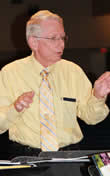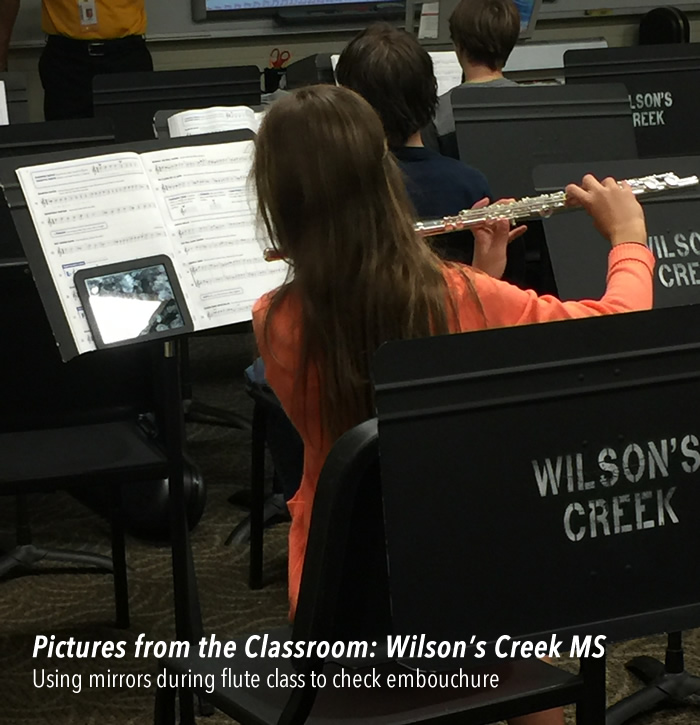Monday, January 11, 2016
IN THIS ISSUE:
Preparing Your Solo | Pics from the Classroom
Preparing Your Solo: The Goal Is Efficient Practicing by John Cheary
Note: For a printable version of this article, please click here.
"A failure to plan IS a plan to fail."
 The first step in the plan is the written work.
The first step in the plan is the written work.
The goal is to learn the music correctly the first time because it is very difficult to unlearn incorrect rhythms and key mistakes.
Here are the instructions:
- Look at the key signatures and mark all the key traps. There are sometimes two traps.
- Put breath marks in at the end of each phrase.
- Find the most challenging rhythms in the piece. Notate rhythms as needed.
- Write in "T" and "S" in slurred passages.
- Bracket the most difficult sections.
- Circle all dynamic changes.
The second step in the plan is to begin playing the music!
- Begin by practicing the bracketed sections first. Play just the notes without rhythms to get them
under your fingers. Then add the rhythm. Play the rhythm on one note. Now combine the notes, the
rhythms and the T & S in the bracketed area. When you can play these areas or "licks" and not look at the music you are ready to move on. - Learn one phrase at a time. When you can play the first phrase well, move to the second phrase.
Then combine the two phrases and so on throughout the piece. - T & S must be correct in the phrase before you move on.
- Dynamics must be correct before you move on. If there are no dynamics write in your own. No
dynamics makes it boring. Dynamics helps to make the music expressive.
Warm up daily to work on tone and tuning (intonation).
Tone and tuning must always be of extreme concern. If you sound like a pig squealing or a frog croaking you won't enjoy playing and no one will enjoy listening.
Having completed all this and confident that you are playing the entire piece correctly, it is now time to play expressively. Play from your heart, praise the Lord with your music!
A Week By Week Plan For Preparing Your Solo
SIX WEEKS BEFORE - Warm up on long tones to develop your tone.
Mark your music in pencil as suggested previously.
FIVE WEEKS BEFORE - Warm up on long tones to develop your tone.
Begin by practicing the bracketed sections first. Play just the notes without rhythms to get them under your fingers. Then add the rhythm. Play the rhythm on one note. Now combine the notes, the rhythms and the T & S (tonguing and slurring) in the bracketed area. When you can play these areas or "licks" and not look at the music you are ready to move on.
FOUR WEEKS BEFORE - Warm up on long tones to develop your tone.
Begin connecting the phrases. For example: Play the 1st and 2nd phrases right in a row without stopping. Then proceed to play the 2nd phrase and 3rd phrases right one after the other. Then combine the 1st through the 4th phrases consecutively. Continue this process to the end.
THREE WEEKS BEFORE - Warm up on long tones to develop your tone.
Now you will begin making the notes and rhythms turn into real music. Check yourself to be sure you are playing all the articulations correctly; staccato, slurring, accents, etc. Then pay all the written dynamics. Finally invent your own dynamics; crescendos and decrescendos where they are not even suggested. You are taking the gigantic step of playing from your heart - expressing your feelings through music. Plan to play your solo for a group of people. Play at church! Even playing for a Sunday School class would be great. Play for your family. The performance experience will help you.
TWO WEEKS BEFORE - Warm up on long tones to develop your tone.
Practice standing up. You will perform you solo standing up so it is best to become accustomed to that feel. Practice with your accompanist often. At first, just plow through so the accompanist can get used to how your are playing the solo. After you get used to each other you can start listening carefully to the piano part and see how the composer has used the harmony to make you sound better.
THE WEEK YOU PERFORM - Warm up on long tones to develop your tone.
Your have done a great job of preparing your solo. You about to have a memorable experience. ENJOY the opportunity to perform. Make sure your instrument is clean and looking good. Plan in advance what you will wear. LOOK GOOD! Create a good first impression for your audience. Have more than one good reed ready to go. Bring a cup for water. Taking a drink just before you perform can be a great aid.
Best wishes for future success!
 |
John Cheary John Cheary is the Director of Bands at School of The Ozarks in Point Lookout, MO. He is a proud graduate of Central Methodist University in Fayette, MO. He was the longtime band director for Monett Schools and also taught at Glendale High School and Branson High School before going into (semi) retirement. John owned/operated Affordable Moving Services, Inc. before getting back into teaching when College of The Ozarks started a private high school. School of the Ozarks has now expanded to include middle school students. John also serves a clinician for "Branson On Stage Live" working with bands from around the country. He lives on Table Rock Lake south of Hollister, Missouri with his wife Jacque Cheary, who also served for years in the classroom. He can be reached by email at [email protected]. |
Pictures from the Classroom
Wilson's Creek MS, Springfield, MO

Contact Your Local Palen Music Center Representative
Can we assist you with
anything? Please contact your local Palen Music Center school road
representative for all of your music education needs.
